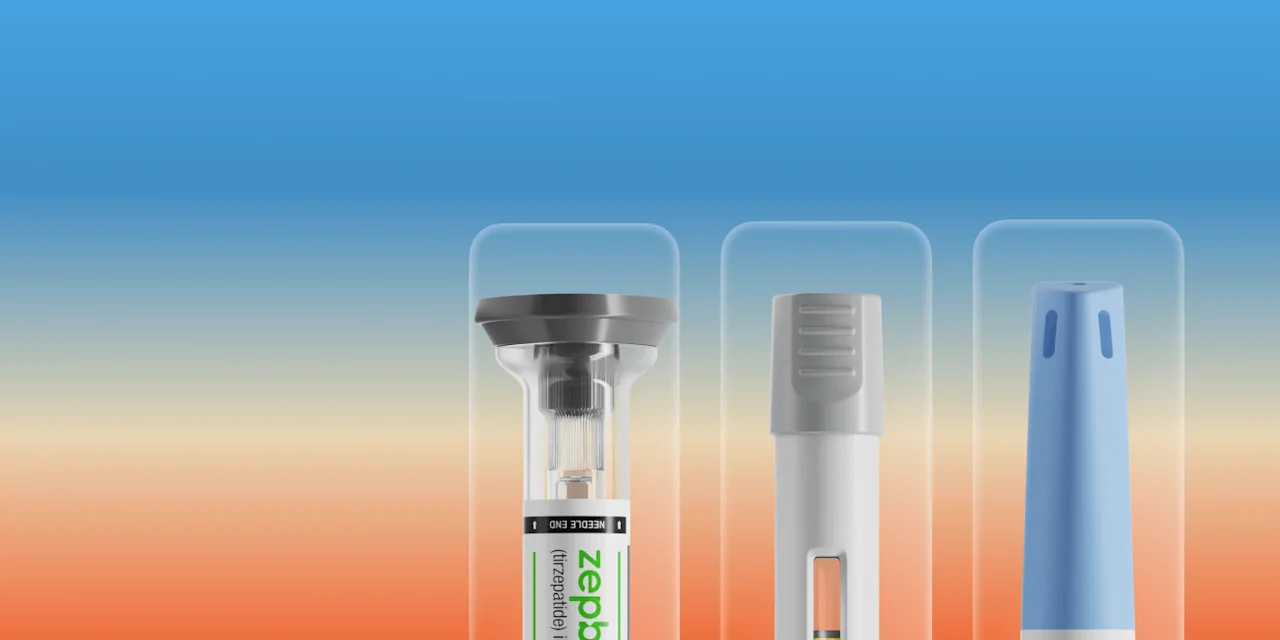Here's what we'll cover
Here's what we'll cover
Gastric bypass and gastric sleeve surgeries are the two most common bariatric surgeries done for weight loss in the United States. While gastric bypass leads to more rapid weight loss and less regained weight than gastric sleeve, the hospital stay can be longer and the surgery can carry more risks. Both procedures are effective for weight loss and there’s a range of things that your healthcare provider will take into account when deciding which procedure is right for you, including your overall health and lifestyle, your motivation for the surgery, and the potential benefits versus risks of the different procedures.
What’s the difference between gastric sleeve and gastric bypass?
Both gastric sleeve and gastric bypass are types of bariatric surgeries used to treat obesity and both work by reducing the amount of food you eat. While gastric bypass surgery reshapes the stomach and reroutes food through the digestive system, gastric sleeve only reshapes the stomach.
With gastric sleeve, the stomach is sewn into a small pouch and the remaining portion of the stomach is removed leaving a smaller space for food. This makes you feel full faster. With gastric bypass, the stomach is sewn into a smaller pouch and then that stomach pouch is reattached further down the digestive tract, effectively reducing the amount of food you can eat.
Gastric bypass | Gastric sleeve | |
|---|---|---|
Procedure | A small portion of the stomach is rerouted to the small intestine, so food bypasses most of the stomach. | A portion of the stomach is removed leaving a tube-like stomach (or “sleeve") rather than a bag-like structure. |
Weight loss results | Weight loss is slightly faster with bypass. After 5 years, bypass patients have lost about 75 percent of their excess body weight | Weight loss is a little slower and a little less in the long term. After 5 years, patients have lost about 65% of their excess body weight. |
Specific risks | Higher risk of dumping syndrome and surgical complications. | Lower risk of dumping syndrome, lower risk of surgical complications, greater risk of needing the procedure redone. |
Both procedures also help reduce diabetes, high blood pressure (hypertension), high cholesterol (hyperlipidemia), and sleep apnea. Also, weight lost with the help of this procedure can help many people begin to maintain a more active lifestyle to improve their overall health and well-being.
Both procedures can be done laparoscopically, a minimally-invasive way of performing surgery that uses a tiny camera. The benefits of laparoscopic surgery are shorter hospital stays and lower rates of complications like surgical site infections and hernias.
While both surgeries result in significant weight loss, people tend to lose more weight after gastric bypass. Since gastric bypass is a more complicated surgery, there’s a slightly higher risk of surgical complications than with gastric sleeve (although the rate of life-threatening complications was the same between gastric bypass and sleeve). Here is some helpful information about both weight loss procedures to help you get started.

Gastric bypass surgery
Gastric bypass accounts for around 20% of the bariatric surgeries performed in the United States every year.
Before the operation, the food you eat travels from your mouth, down your esophagus, and into your stomach. From there it enters the first part of your small intestine, called the duodenum, travels into the second and third parts, and then enters your large intestine or colon.
In gastric bypass surgery, the stomach is reshaped into a smaller pouch, and that smaller pouch is disconnected from the first part of your small intestine and reattached to the second part. The remaining part of your stomach stays put as a separate pouch. This setup allows food to bypass a significant portion of the digestive system, so fewer nutrients are absorbed. This, coupled with having a smaller stomach, leaves you feeling full after eating less.
Gastric sleeve surgery
Gastric sleeve surgery, also called sleeve gastrectomy, is the most commonly performed bariatric surgery in the United States, making up about 60% of operations.
During the procedure, about three-quarters of the stomach is removed and the remaining portion is shaped into a tube or sleeve. Like with gastric bypass, the stomach now holds less food, and you feel full after eating less. Unlike gastric bypass, there is no rearranging of the stomach and small intestine.
Within the first three years after sleeve gastrectomy, people generally lost around 58% of their excess body weight. Some weight regain can occur and one of the main issues with gastric sleeve is that the stomach can stretch out again to full capacity if the person doesn’t adhere to careful lifestyle changes. Overall, people who undergo gastric sleeve surgery are more likely to need the procedure again compared with people who undergo gastric bypass.
Is one surgery safer than the other?
The bariatric procedures performed today are relatively safe, although gastric bypass has a higher rate of complications. And while gastric sleeve carries fewer surgical risks, a large analysis of nearly 100,000 patients showed that more people needed to have the surgery redone when it was a sleeve operation versus bypass. Still, that proportion of patients was very low 3% versus 1.5% roughly.
All surgical procedures can carry risks but in general, laparoscopic surgery (in which surgical devices are inserted into the body through small, coin-sized incisions) is fraught with fewer problems than open surgeries (where large incisions are made). Since both gastric bypass and gastric sleeve are done via laparoscopic surgery, the complication rate is low—especially compared to open surgery.
In a study comparing the two procedures, gastric bypass had more risks, such as infections at the surgical site and non-life-threatening bleeding. More severe complications, like blockages in the digestive tract or leakage from the sites where the digestive tract was stitched, are rare with both procedures.
Most people don't stay in the hospital very long and can usually go home within two to five days after the operation. In a study looking at recovery times following gastric bypass specifically, most patients were safely discharged the day after.
Factors that determine how long you stay in the hospital include whether you can tolerate a liquid diet to go home on, the amount of pain you have, and if complications occur.
Who qualifies for weight loss surgery?
Not everyone should undergo gastric bypass or sleeve gastrectomy. The first step to understanding who qualifies for weight loss surgery is a consultation with a bariatric surgeon to determine if you’re a good fit for one of these procedures. The American Society for Metabolic and Bariatric Surgery (ASMBS) uses the following criteria for determining who might be a good candidate for bariatric surgery:
Adults with a body mass index (BMI) greater than 35 regardless of the presence of any additional related conditions.
Adults with a BMI between 30 and 35 who also have a diagnosis of type 2 diabetes, obstructive sleep apnea, high blood pressure, high cholesterol, fatty liver, asthma, blood vessel disease, debilitating arthritis, impaired quality of life, or another condition that makes it difficult for them to function.
What does recovery look like after surgery?
The recovery period can vary from person to person, as everyone heals at their own pace. Life after gastric surgery will require some adjustment.
After the operation, patients are typically started on a clear liquid diet to ensure that they are hydrated and to give the digestive system some time to heal. Non-clear liquids are then added but many people are released from the hospital before they have advanced to solid foods. The liquid diet may last as long as 14 days and your healthcare provider will give you a detailed plan regarding what you can and can’t eat, as well as follow up with you during clinic visits to monitor your dietary progress.
Here are some other things to be mindful of after surgery, such as what to eat, nutritional needs, and potential complications.
Nutritional needs
Bariatric surgery changes the way you absorb food, which can expose you to nutrient deficiencies. Supplements can help if you have low levels of any nutrient after surgery, commonly folate, iron, and B12.
Nutritional deficiencies can occur following either procedure, although deficiencies are more common after gastric bypass than after gastric sleeve. That’s because the stomach plays an important role in the absorption of certain nutrients so removal of a significant portion of the stomach can result in malabsorption (which is when a person can’t get enough nutrients to support their body’s needs).
Some people also experience reflux, or GERD (gastroesophageal reflux disease) after these procedures, which is when food comes back up after you eat accompanied by gastric juices. This can cause a burning sensation in the chest (also known as heartburn) but typically resolves as a person learns how much they can eat.
Additional complications can include blood clots (which can happen after any major surgery) as well as gallstones (also known as cholelithiasis). Gallstones can affect about 20% of people who undergo dramatic weight loss and typically show up in the first couple of years after the operation. Many healthcare providers prescribe a medication called ursodiol to prevent this complication and while the condition can resolve on its own, some people require an additional procedure to remove the gallbladder if it persists.
Dumping syndrome
One of the complications that can happen after gastric bypass is something called dumping syndrome, which is when food moves too rapidly through the digestive system. Common signs of dumping syndrome include dizziness, nausea, sweating, diarrhea, and abdominal pain. It can also lead to hypoglycemia, or low blood sugar, which can be dangerous. Symptoms are typically more severe in younger people (under the age of 35) and in those with a lower BMI.
The recommended treatment for dumping syndrome is diet modification to avoid foods that cause symptoms—most often simple carbohydrates, like foods that contain refined sugar. Opting for more complex sugars, such as those found in vegetables, fruits, and whole grains as well as foods high in fiber can also help, as fiber prolongs the transit time of food through your digestive tract. Dumping syndrome usually disappears after one year for most people.
Overall, gastric bypass and gastric sleeve are both relatively safe procedures. Gastric bypass is associated with more weight loss and better diabetes control but carries more complication risks than gastric sleeve. The good news is that with either procedure people reported a marked improvement in their quality of life within the first year. This included improvements in physical functioning, a better social life, and more independence in daily living activities like bathing and dressing.
Alternative weight loss options
Lap band surgery
Lap band surgery is a procedure that is typically no longer performed by bariatric surgeons. Of the roughly 200,000 bariatric surgeries performed in a given year, 59% are sleeve gastrectomies and just about 1% are lap band surgeries. During this procedure, a small ring is placed around the top of the stomach from the outside, applying pressure to the stomach to make people feel full faster. And while the procedure is one of the safest bariatric surgeries in terms of mortality, it has by far the highest rate of complications with nearly 50% of patients needing additional surgery down the line to remove the device or perform an additional bariatric surgery.
GLP-1 receptor agonist medications (like Ozempic)
While a relatively new player in the weight management field, GLP-1 receptor agonist drugs like semaglutide (available under brand names like Ozempic and Wegovy) are effective, non-invasive alternatives to bariatric surgery. These drugs, which have surged in popularity, offer many of the same benefits with far fewer risks.
Bariatric surgery like gastric sleeve or gastric bypass isn’t for everyone, but for some people, it can be a life-saving procedure. A trusted healthcare provider can work with you to perform a thorough evaluation and help you understand which procedure, if either, is right for you.
DISCLAIMER
If you have any medical questions or concerns, please talk to your healthcare provider. The articles on Health Guide are underpinned by peer-reviewed research and information drawn from medical societies and governmental agencies. However, they are not a substitute for professional medical advice, diagnosis, or treatment.
American Society for Metabolic and Bariatric Surgery (ASMBS). (2021). Who is a candidate for bariatric surgery? ASMBS. Retrieved on Apr. 16, 2021 from https://asmbs.org/patients/who-is-a-candidate-for-bariatric-surgery
Andreasson, K. & Videhult, P. (2017). Gastrisk bypass eller sleeve-gastrektomi – vilken är bäst? [Gastric bypass versus sleeve, pros and cons]. Lakartidningen , 114 , ER3H. Retrieved from https://lakartidningen.se/klinik-och-vetenskap-1/kommentar/2017/09/gastrisk-bypass-eller-sleeve-gastrektomi-vilken-ar-bast/
Clapp, B., Ponce, J., DeMaria, E., et al. (2022). American Society for Metabolic and Bariatric Surgery 2020 estimate of metabolic and bariatric procedures performed in the United States. Surgery for Obesity and Related Diseases: Official Journal of the American Society for Bariatric Surgery , 18 (9), 1134–1140. https://doi.org/10.1016/j.soard.2022.06.284. Retrieved from https://pubmed.ncbi.nlm.nih.gov/35970741/
Eisenberg, D., Shikora, S. A., Aarts, E., et al. (2022). 2022 American Society for Metabolic and Bariatric Surgery (ASMBS) and International Federation for the Surgery of Obesity and Metabolic Disorders (IFSO): Indications for metabolic and bariatric surgery. Surgery for Obesity and Related Diseases: Official Journal of the American Society for Bariatric Surgery , 18 (12), 1345–1356. https://doi.org/10.1016/j.soard.2022.08.013. Retrieved from https://pubmed.ncbi.nlm.nih.gov/36280539/
Fearon, N. M., Kearns, E. C., Kennedy, C. A., et al. (2022). The impact of ursodeoxycholic acid on gallstone disease after bariatric surgery: a meta-analysis of randomized control trials. Surgery for Obesity and Related Diseases: Official Journal of the American Society for Bariatric Surgery , 18 (1), 77–84. https://doi.org/10.1016/j.soard.2021.10.004. Retrieved from https://pubmed.ncbi.nlm.nih.gov/34772614/
Golomb, I., Ben David, M., Glass, A., et al. (2015). Long-term metabolic effects of laparoscopic sleeve gastrectomy. JAMA Surgery , 150 (11), 1051–1057. https://doi.org/10.1001/jamasurg.2015.2202. Retrieved from https://pubmed.ncbi.nlm.nih.gov/26244446/
Hahl, T., Peromaa-Haavisto, P., Tarkiainen, P., et al. (2016). Outcome of laparoscopic gastric bypass (LRYGB) with a program for enhanced recovery after surgery (ERAS). Obesity Surgery , 26 (3), 505–511. doi: 10.1007/s11695-015-1799-z. Retrieved from https://pubmed.ncbi.nlm.nih.gov/26205214/
Howard, R., Chao, G. F., Yang, J. et al. (2021). Comparative safety of sleeve gastrectomy and gastric bypass up to 5 years after surgery in patients with severe obesity. JAMA Surgery, 156 (12), 1160–1169. doi:10.1001/jamasurg.2021.4981. Retrieved from https://jamanetwork.com/journals/jamasurgery/fullarticle/2784823
Khoraki, J., Moraes, M. G., Neto, A. P. F., et al. (2018). Long-term outcomes of laparoscopic adjustable gastric banding. American Journal of Surgery , 215 (1), 97–103. https://doi.org/10.1016/j.amjsurg.2017.06.027. Retrieved from https://pubmed.ncbi.nlm.nih.gov/28693840/
Lager, C. J., Esfandiari, N. H., Subauste, A. R., et al. (2017). Roux-En-Y gastric bypass vs. sleeve gastrectomy: balancing the risks of surgery with the benefits of weight loss. Obesity Surgery , 27 (1), 154–161. doi: 10.1007/s11695-016-2265-2. Retrieved from https://pubmed.ncbi.nlm.nih.gov/27342739/
Ma, I. T. & Madura, J. A. (2015). Gastrointestinal complications after bariatric surgery. Gastroenterology & Hepatology , 11 (8), 526–535. Retrieved from https://www.ncbi.nlm.nih.gov/pmc/articles/PMC4843041/
Maciejewski, M. L., Arterburn, D. E., Van Scoyoc, L., et al. (2016). Bariatric surgery and long-term durability of weight loss. Journal of Academic Medicine Surgery , 151 (11), 1046–1055. doi: 10.1001/jamasurg.2016.2317. Retrieved from https://www.ncbi.nlm.nih.gov/pmc/articles/PMC5112115/
Major, P., Matłok, M., Pędziwiatr, M., et al. (2015). Quality of life after bariatric surgery. Obesity Surgery , 25 (9), 1703–1710. doi: 10.1007/s11695-015-1601-2. Retrieved from https://pubmed.ncbi.nlm.nih.gov/25676156/
McTigue, K. M., Wellman, R., Nauman, E., et al., & PCORnet Bariatric Study Collaborative (2020). Comparing the 5-year diabetes outcomes of sleeve gastrectomy and gastric bypass: the national patient-centered clinical research network (PCORNet) Bariatric Study. Journal of the American Medical Association Surgery , 155 (5), e200087. doi: 10.1001/jamasurg.2020.0087. Retrieved from https://pubmed.ncbi.nlm.nih.gov/32129809/
Mitchell, B. G. & Gupta, N. (2020). Roux-en-Y Gastric Bypass. StatPearls . Retrieved Mar. 2, 2021 from https://pubmed.ncbi.nlm.nih.gov/31985950/
Reoch, J., Mottillo, S., Shimony, A., et al. (2011). Safety of laparoscopic vs open bariatric surgery: a systematic review and meta-analysis. Archives of Surgery , 146 (11), 1314–1322. doi: 10.1001/archsurg.2011.270. Retrieved from https://pubmed.ncbi.nlm.nih.gov/22106325/
Sepúlveda, M., Alamo, M., Saba, J., et al. (2017). Long-term weight loss in laparoscopic sleeve gastrectomy. Surgery for Obesity and Related Diseases , 13 (10), 1676–1681. doi: 10.1016/j.soard.2017.07.017. Retrieved from https://pubmed.ncbi.nlm.nih.gov/28807556/
Stahl, J. M. & Malhotra, S. (2020) Obesity Surgery Indications And Contraindications. StatPearls. Retrieved on Mar. 6, 2020 from https://www.ncbi.nlm.nih.gov/books/NBK513285/#NBK513285_pubdet










